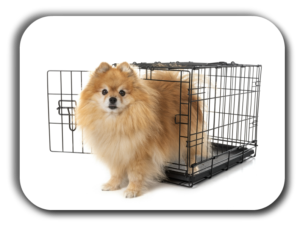Dog owners are often split over the use of a crate for their dogs. Some Dog owners will tell us that the crate is the best thing possible for their dogs. They tell us that it keeps them calm and provides a great level of safety and protection. Other dog owners think that the crate is horrible and compare it to a jail or prison. This debate has been raging for a very long time and will probably continue to rage long into the future.

Robin and I think that the crate is a great training, safety, and behavior tool. We say this both as professional dog trainers and the owners of many, many dogs over the years. The explanation that we provide the well intentioned dog owners that don’t like the crate is that they are approaching the use of a crate from the human perspective. Once they understand the canine perspective of what the crate represents, they may just change their minds…
Your dog thinks of your home as his den. For many dogs, a house or apartment is too large and can be the source of unwanted stress and confusion.
A dog that is properly introduced to a crate will view it as his or her own sanctuary. It is their happy place and the one place in their universe where everything will be fine all the time.
Let’s start with some important points to consider:
- You should never think of a crate as a substitute for training and supervision.
- Normally, you should not keep your dog in his crate for longer than 4 – 8 hours. The length of time depends on the dog’s age, temperament, and bladder size.
- A crate does not need to be “a mansion”. You only need it large enough for a dog to stand up, lay down comfortably and turn around.
- A crate should never be used as punishment.
It is critical that you understand the appropriate way to introduce your dog to their crate. Doing this incorrectly could lead to a lifetime of inappropriate behavior.
- It is important to create a positive, pleasant association for your dog with his crate so that he will enjoy spending time there.
- Place a worn t-shirt or other piece of clothing or bedding in the crate. The “this is part of us” smell will help create a comforting and inviting environment for your dog.
- If it is too bright or loud where you have the crate, create a comforting environment by covering three sides of the crate with a blanket or quilt.
- Encourage your dog to explore the crate by placing toys, treats, food and water inside.
- Lavish your dog with praise when he enters the crate on his own.
- Initially leave the door open whenever your dog goes inside the crate. After a while, start closing the door when he is occupied or napping.
- Do not remove your dog from crate if whines. Wait until he is quite. You want to make sure that you do everything on your terms. The one exception to this is if he has to potty. In that case, let him out now!
Now, let’s talk about your dog’s crate and it’s important role in the potty training process.
- Your dog really doesn’t want to potty where he eats or sleeps. If you use the crate properly with this in mind, you can speed up the potty training process.
- The first thing to do is to make sure the crate is only large enough for your puppy to stand up, turn around and lay down. This will help the your puppy develop bladder control.
- Do not put anything like bedding or towels in the crate. Most puppies don’t like sitting in their poop or urine. If you put bedding or towels in the crate, this could absorb the “potty” and make it not as distasteful for the puppy.
- Since puppies (and all dogs) don’t like to potty where they eat, feed your puppy in the crate. Scatter food on the floor of the crate. This is not only fun for your puppy, but it also creates a bigger area where he will “not want to go”.
- Sometime when you take your puppy outside for their potty break, they spend the “outside time” having too much fun running and jumping. They forget to potty when they are out. If this happens, place your puppy in crate for 10-15 minutes, then take him back outside. This helps avoid the very common problem of the puppy going potty in the house after having just been outside.
Please call Robin or me at (770) 718-7704 if you need any dog training help. We are blessed to have been your local dog training professionals for over fifteen years. We have trained over 5,000 great dogs and loving families and are ready to help you.

Follow Us!